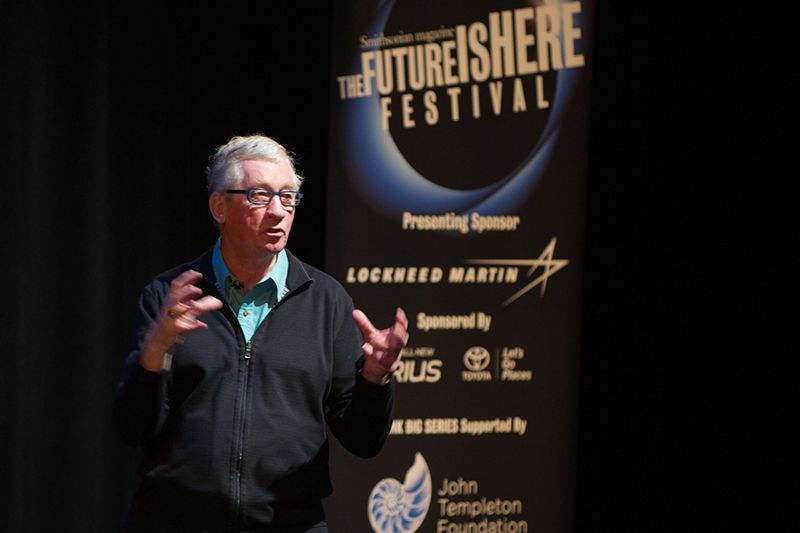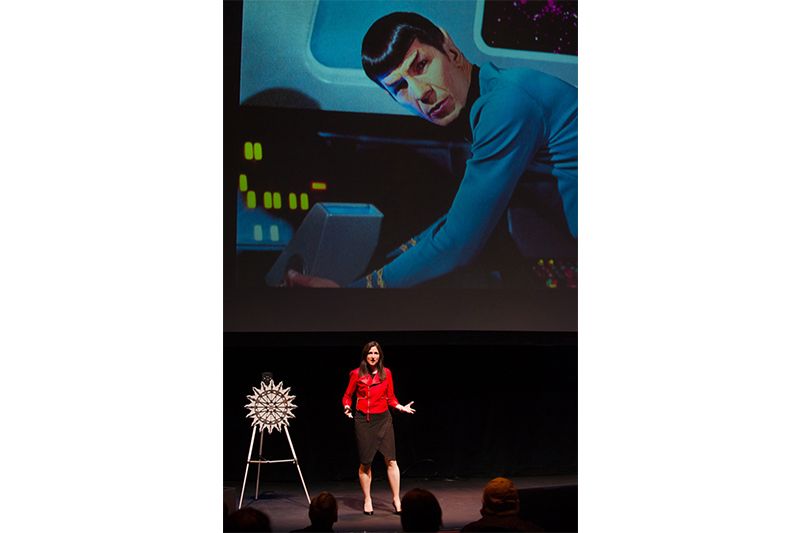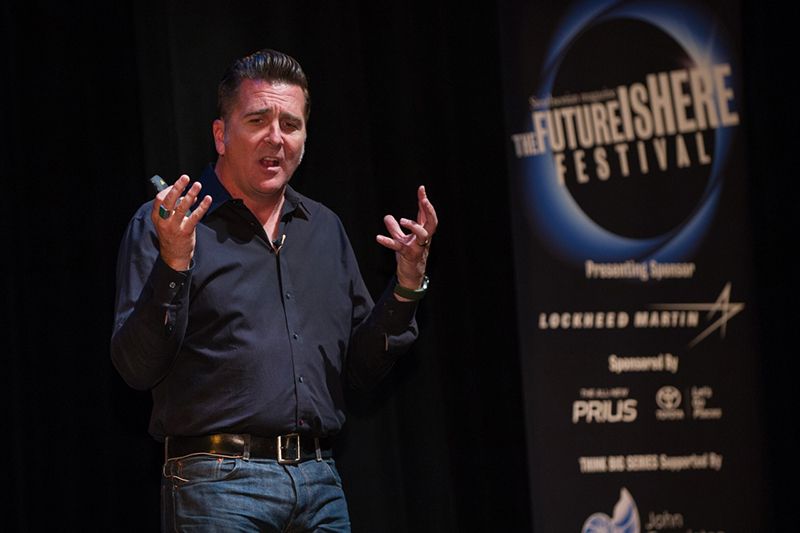The Future Is Here Festival Considers Extraterrestrial Life and the Essence of Humanity
In the festival’s final day, speakers turn to the cosmos and our place within it
:focal(518x133:519x134)/https://tf-cmsv2-smithsonianmag-media.s3.amazonaws.com/filer/44/7a/447a0cdb-0f46-4889-806a-232c75392632/jim-green.jpg)
There’s no good reason to expect that alien life, should any prove detectable, will be created in humanity’s image as Hollywood films tend to model them, said Seth Shostak, director of the Search for Extraterrestrial Intelligence (SETI) on Sunday at Smithsonian magazine’s “Future is Here” festival in Washington, D.C. Shostak, by the way, consults with film companies on alien depictions.
“Hollywood usually resorts to little gray guys with big eyeballs, no hair, no sense of humor and no clothes, because it saves a whole lot of backstory,” he said. “We’ve been rather anthropocentric. We assume that they’re somewhat like we are. That may be fundamentally wrong.” In response to an audience member’s question, he added, “Our data set on alien sociology is sparse.”
Extraterrestrial life is likely to be more computer-like than human in nature. Just as humans are building artificial intelligence, aliens may do the same, Shostak said, and instead of finding the kinds of aliens that show up in movies, humans could be more likely to encounter the robots or computer systems created by the aliens. So humans who hope to find extraterrestrial life ought to look in places that are different than how we've imagined them to date. Further-evolved alien life probably doesn’t require planets with water and oxygen, as people do, Shostak said.

Shostak's critique of popular culture's take on aliens' appearance was one of many critiques raised at the festival, which played host to scientists, philosophers, authors and engineers. While there, they envisioned a future where science meets science fiction. Sunday’s lineup of speakers, supported in part by the John Templeton Foundation, included Frans de Waal, a professor of primate behavior at Emory University; Marco Tempest, a “cyber illusionist”; Rebecca Newberger Goldstein, a philosopher and author; Sara Seager, a planetary scientist and astrophysicist; and several NASA scientists and engineers.
As varied as they were, the talks had one common thread: Human narcissism can be rather misleading and unproductive at times, while at others, it may hold great scientific promise.
If aliens are too often thought of in human terms, there is the opposite tendency to underappreciate animal ingenuity because they are compared to human intelligence. That sells dolphins, apes, elephants, magpies, octopi and others short, said de Waal, a primatologist. He’d rather scientists allow for more elasticity in adopting an anthropomorphic set of vocabulary and concepts to consider certain animals as rather more like humans.

De Waal showed a video of a bonobo carrying a heavy rock on its back for half a kilometer until it arrived at the hardest surface in the sanctuary, where it used the rock to crack open some nuts. “That means she picked up her tool 15 minutes before she had the nuts,” de Waal said. “The whole idea that animals live only in the present has been abandoned.”
He showed a video of a chimp and another of an elephant each recognizing itself in a mirror, opening wide to gain an otherwise inaccessible view of the insides of their mouths. “If your dog did this, you’re going to call me,” he said.
All animal cognition, clearly, isn’t created equally, but de Waal stressed that for the animals that do exhibit cognition, it’s hardly a sin to use anthropomorphic terms to describe, say, a chimp laughing when tickled. It certainly looks and functions like a human laugh, he said.
The focus first on yet-unknown, and perhaps not-even-existent, alien life, and then on very familiar creatures, with which we share the planet, served as a microcosm of the broader scope of the day’s agenda. Laying the groundwork for the notion that the future has arrived already, Michael Caruso, editor-in-chief of Smithsonian magazine, told the audience to consider itself as a group of time machines.
“Your eyes are actually lenses of a time machine,” he said, noting that the further into space we look, the more of the past we see. “The light from the moon above us last night came to us a second and a half old. The light from the sun outside today is eight minutes and 19 seconds in the past. The light that we see from the stars at the center of the Milky Way is actually from the time of our last ice age, 25,000 years ago. Even the words I’m speaking right now, by the time you hear them exist a nanosecond in the past.”
While everything surrounding attendees represents the past, they themselves are the future. The key, he said, is to share knowledge, compare notes and overlap what we all know.
“That’s what we do here at the festival,” Caruso said.

Other speakers picked up where Shostak and de Waal left off. In the search for extraterrestrial life, scientists are studying exoplanets, or planets that orbit stars other than the sun. Some of these, said Seager, a MIT professor of planetary science and physics, display ripe conditions to support life. “We know that small planets are out there waiting to be found,” she said. Though that doesn’t mean it’s easy hunting. “I liken it to winning the lottery—a few times,” she said.
Philosopher and writer Rebecca Newberger Goldstein, meanwhile, turned the lens not on planets many light years away, but instead on the human condition domestically. She discussed what she called the “mattering map,” a spectrum upon which individuals weigh and evaluate the degree to which they matter. “We are endowed with a mattering instinct,” she said. Or put another way: Everyone has an address on the mattering map, “an address of your soul.”
So much psychic power is embedded in the notion of mattering, she added, that people often give up their lives to secure the opportunity to matter, or if they feel they no longer matter. This is particularly relevant in the age of social media, and selfies, she said, when there is a temptation to measure how much one matters based on others’ approval.
“Who doesn’t like it when their Twitter following grows?” she asked.
Other speakers filled in more holes in the broader conversation about the future colliding with the present. “What was once magic is now reality,” said Marco Tempest, a “cyber illusionist” whose magic performance was enhanced by digital elements. He performed a card trick while wearing a digital headset, and the audience saw, presumably, what he saw projected on a screen. The projection overlaid digital information atop the cards, sometimes animating certain elements and other times adding additional information. Magicians and hackers are alike, Tempest said, in that they don’t take what surrounds them at face value. They see material as something to be played with, examined and questioned, rather than taken for granted.

A variety of National Aeronautics and Space Administration representatives, including Dava Newman, NASA’s deputy administrator, discussed everything from Hollywood depictions of space exploration to augmented and virtual reality. NASA’s mission is “off the Earth, for the Earth,” Newman said. She stressed that everything that NASA does, particularly when it comes to areas that are quite far from Earth, relates back to what is best for people on Earth. So it's off the planet, but it's all for the benefit of the planet. Jim Green, who directs NASA’s planetary science division, spoke highly of art’s capacity to impact the real-life space program. “Science fiction is so important to our culture, because it allows us to dream,” he said.
That melding of dreaming and reality, of searching for what humanity has never encountered, such as extraterrestrial life and new planets, is a vital mix that helps keep things grounded, said Seager, the astrophysicist, in an interview after her talk.
“We do have our ultimate goal, like the Holy Grail. I don’t want to say we may never find it [extraterrestrial life], but that thought is always kind of there,” she said. “At least we will be finding other stuff along the way.”
/https://tf-cmsv2-smithsonianmag-media.s3.amazonaws.com/accounts/headshot/mw_by_vicki.jpg)
/https://tf-cmsv2-smithsonianmag-media.s3.amazonaws.com/accounts/headshot/mw_by_vicki.jpg)